A paint that turns walls into whiteboards.
Encountering this paint became the catalyst for creating a new educational program.
"World-building" energizes people
Do you remember the childhood experience of building a "secret base" with friends?
Growing up in a housing complex, I too have memories of building a base with friends on a slope covered in pampas grass and playing there after school.
Looking back, it was completely visible from the outside and not really secret, but having our own space set our minds free.
Beyond the "fairly guaranteed places" like home or classrooms, the act of "world-building" – creating your own space, starting with childhood make-believe games or playing heroes – is said to make children's activities more proactive.
Club rooms for extracurricular activities, or that regular seat at your favorite coffee shop, could also be seen as forms of world-building.
The catalyst was an encounter with a startup
It all started with an inquiry email that landed at the lab. That email led to meeting Mayumi Sawada, the Japanese distributor for IdeaPaint, a paint developed by a startup founded by three American college students.
We learned that in the US, they had installed their paint in the offices of renowned organizations like NASA, Google, and Apple. Hearing there was a demo wall at their Odaiba office, I invited Mr. Akihiro Honda, the art director at our research institute, to go check it out.
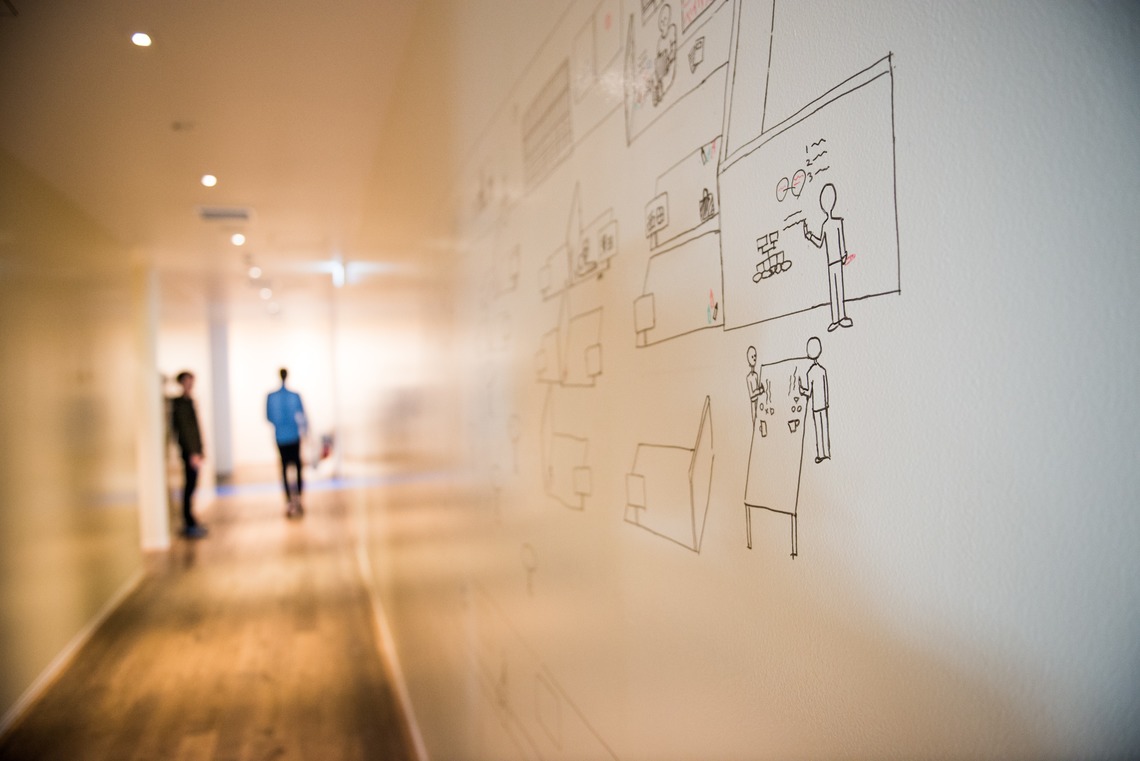
The entire wall on the first floor of the Odaiba office is a whiteboard created using IdeaPaint
We also learned that with expert guidance and support, students of any grade level could adopt it. Using transparent IdeaPaint allows for free design of the base layer, so students can freely design the shape and color of the whiteboard itself.
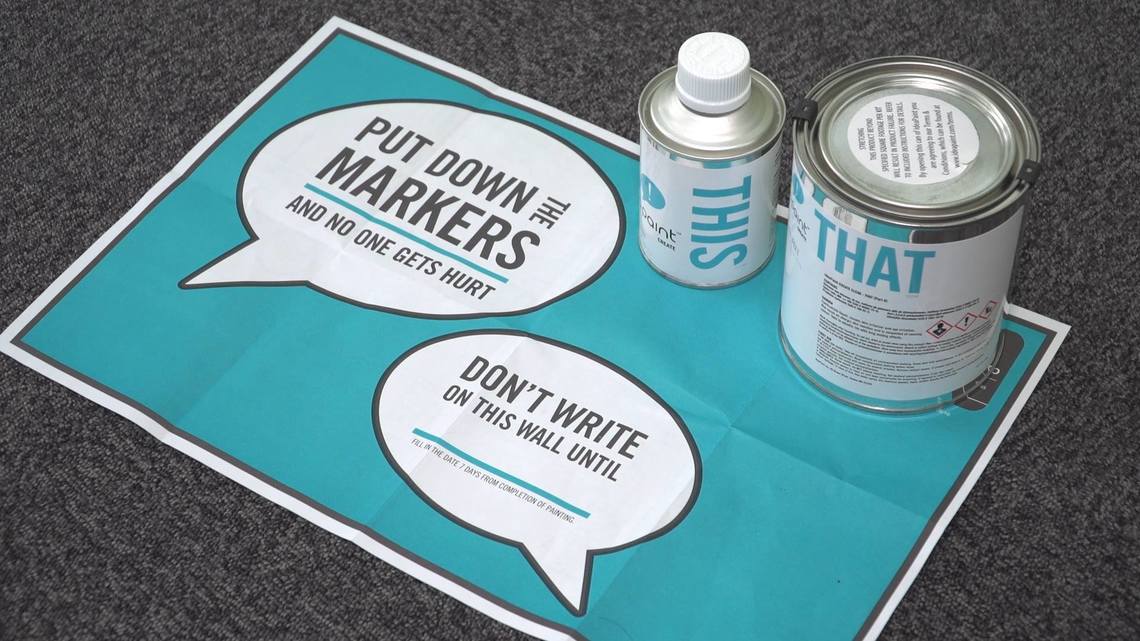
IdeaPaint Product: Mix the base agent (THAT) with the hardener (THIS), then apply to the wall.
Most previous implementation cases involved receiving an order, undertaking the installation, and delivering the finished product.
If we're going to be involved, wouldn't it be more fun to turn the creation process itself into an educational program?
What if schools had "their own secret hideout"?
In educational settings, the quality of ideas generated by students themselves might change.
We wanted content that encourages "world-building" to activate people within the learning environment. So, we, the research lab members, created a workshop that transforms dead space in schools into places for their own thinking.
We called it "The Secret Thinking Base."
Takasaki University of Commerce, which had a history of collaborating with our institute, volunteered to be the first school to implement it.

Secret Thinking Base Logo
We aimed for a festival vibe
We divided the 20 participating members—from different grades and departments—into three groups. After a brief explanation of the concept, we first had them explore the school.
"Who knew the school had places like this?" "This spot could actually be a pretty good space, huh?" The buzz started early. It was fascinating to see how members naturally bonded as they stepped out of classrooms, walking and talking and brainstorming together.
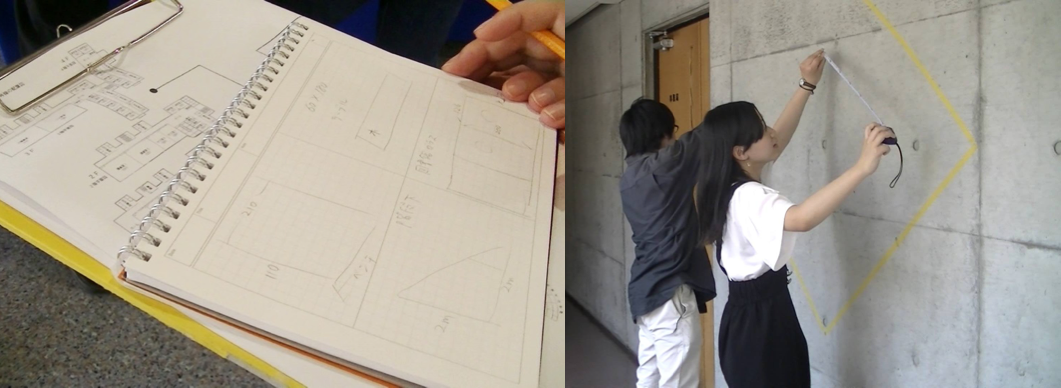
Armed with the three essential tools: a map, a measuring tape, and masking tape
When they found a promising spot on campus, they checked its dimensions. They confirmed the location and scale.
After exploring, we all walk around the spots we found, each person highlighting the strengths of their candidate locations. What kind of space could we create if a whiteboard were placed in this dead space? Could we build a user-friendly environment? Serious discussions begin.
We considered various scenarios, like "It might be noisy because of heavy foot traffic" or "It could feel a bit dark and lonely on cloudy days," and selected six best locations.
Since we're at it, let's go for an original shape and color.
Next came the design phase. Student-like, free-thinking ideas flowed one after another. But would that design actually work in the installation space? What about the color? If it's too dark, might it be hard to use as a whiteboard? Aiming for a design that would last, some suggested choosing minimalist shapes while experimenting with the coloring. Ultimately, this became homework for the next session.
Later, designs for all six were finalized. Students selected colors themselves from the color chart and ordered the paint. Next time, it's finally time for installation.
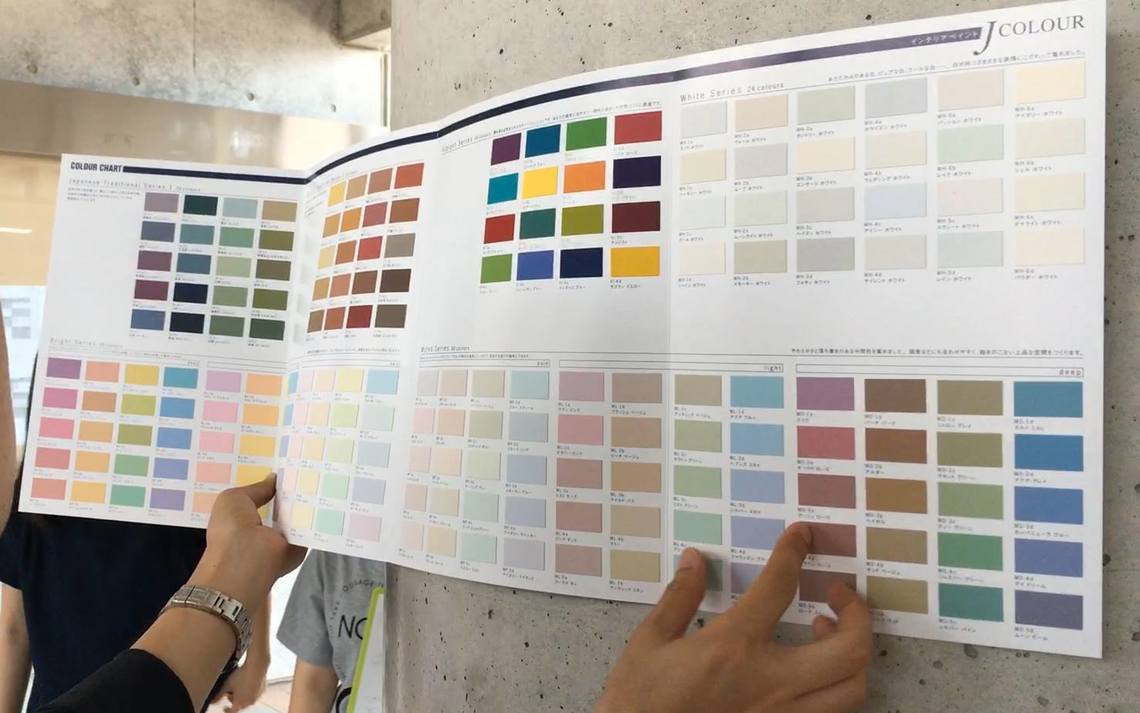
There are many shades of white. Together, we select one that fits each location.
It's been ages since I worked in clothes this ready to get dirty!
The day of the construction work, everyone gathered in work clothes. We were fully prepared to get covered in paint. The members listened intently to the thorough lecture on how to paint neatly: masking techniques, roller usage, the right amount and number of coats. One member muttered as they applied the tape and painted.
"This really shows your personality, doesn't it?"
In no time, the base design was complete. We let it dry for 24 hours. The next day, we finally applied the transparent IdeaPaint. Since uneven coverage is a no-no, we carefully applied multiple layers. After letting it dry thoroughly for a full week, our original whiteboard was complete.
*Walls with uneven surfaces or cracks must be smoothed out beforehand by a professional contractor.
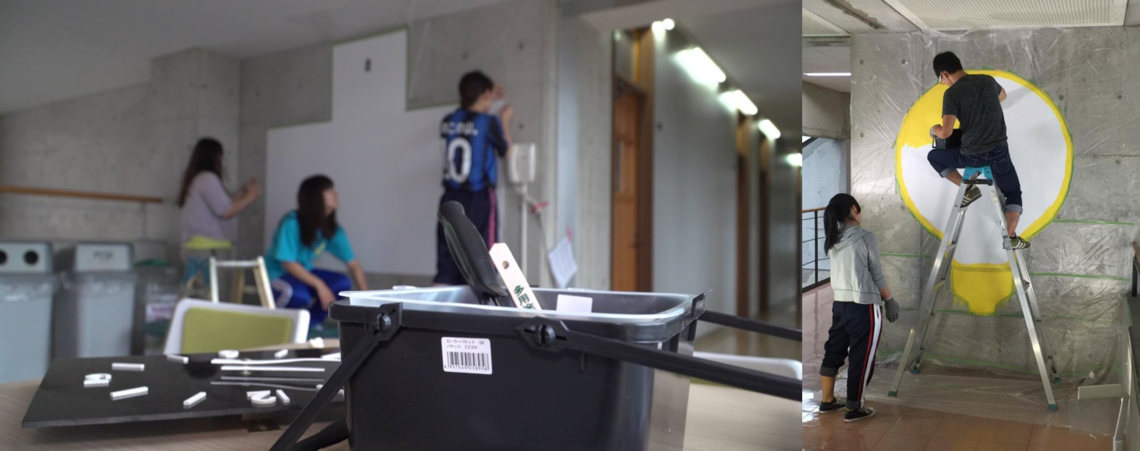
We were taught that meticulous masking is crucial, and they tackled the detailed work with precision.
We felt ideas flowed more freely than in a rented classroom
For the third workshop session, we actually used our own "secret thinking base" for group work.
The theme was: "Freely brainstorm products and services you've never seen before."
We looked for things and experiences around us that we use or encounter often, but which haven't actually evolved for a long time, and wrote down as many as possible.
Once each group decided on a development target, the next step was new combinations.
To generate fresh ideas, they wrote down things like "people who come to mind right now," "times or places that make your heart race a little," or "features of things you like," then randomly docked them with their development targets. This forced brainstorming led to unexpected ideas.
The result? Product ideas leading to new experiences were born in just a few hours, such as: * A toothbrush that plays music through bone conduction * A backpack for street performances * Underwear that gently wakes you up * Socks that provide a foot pack
We also asked participants about their experience using the method.
"It's better than renting a big classroom and gathering desks—you can think calmly without worrying about others around you."
"You won't get scolded for laughing hysterically during casual chatter, so this is a good option for brainstorming fun projects."
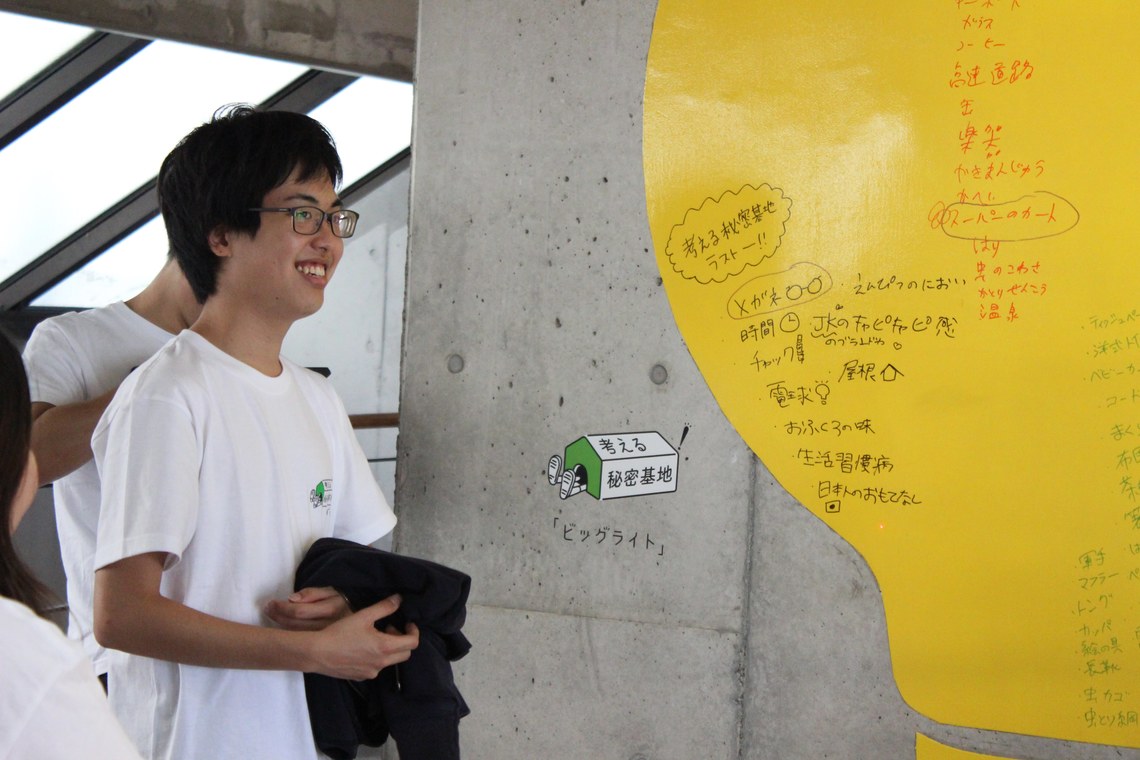
Since it's our own open space, laughter naturally fills the air.
It's also being used for summer programs and graduation projects.
We're thrilled to report visitors have already come to see it.
For schools finding it difficult to incorporate this into their regular curriculum, it can be utilized as a special summer program—when students have more free time and construction is easier—or as a gift-making project for current students by graduates.
We aim for these "secret bases for thinking," created by students for students, to quietly increase in schools across the nation.
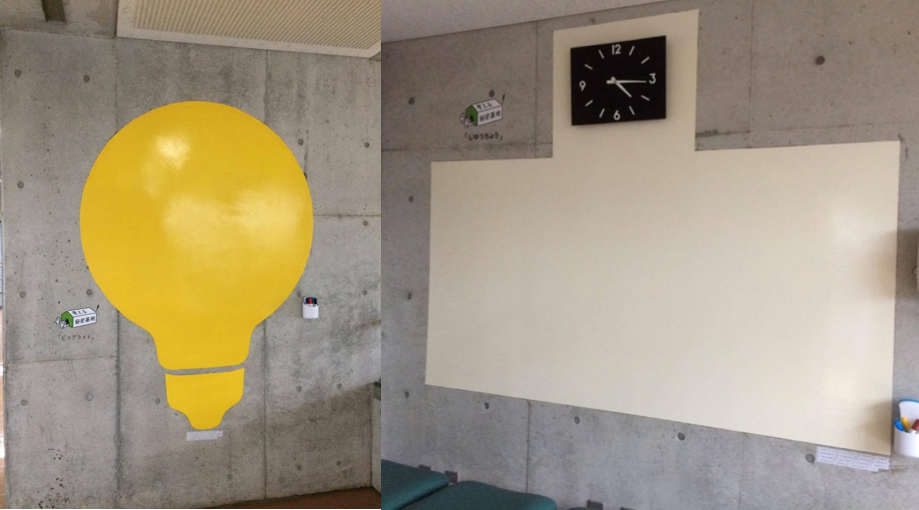
Left is Big Light, right is Blank Map. The students themselves came up with the titles.
Do you decide your own workspace in the office?
Today, new office work styles that aren't tied to fixed desks are gradually spreading in business settings. Even so, many people likely find themselves unconsciously working within the environment provided as the norm.
Conversely, some adopt a style-first approach, using creative spaces to "get carried away with their own ideas."
Often, what seems like choice is actually being chosen for you.
There's no such thing as an all-in-one, absolute place for learning. This holds true not only in the real world but also in virtual technology spaces like VR.
Purposely placing yourself in a different environment where you can breathe a different air—or even imagining and creating the optimal environment for yourself. If you want to meet a fresh version of yourself, it's worth a try.
This time, it's a small "What about this?" idea about such environments for thinking.













